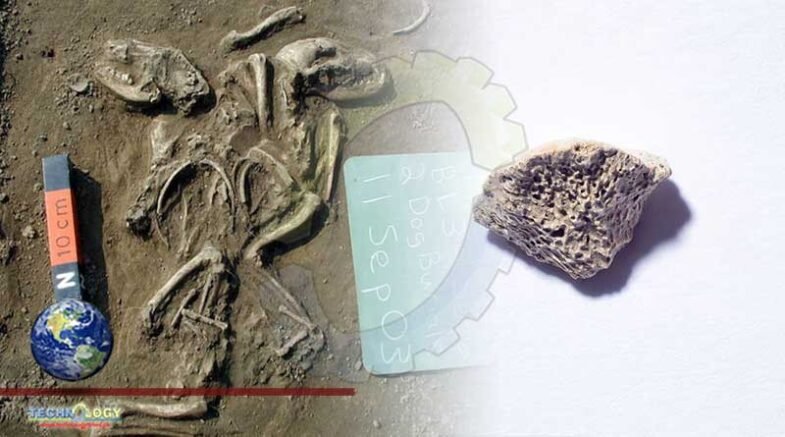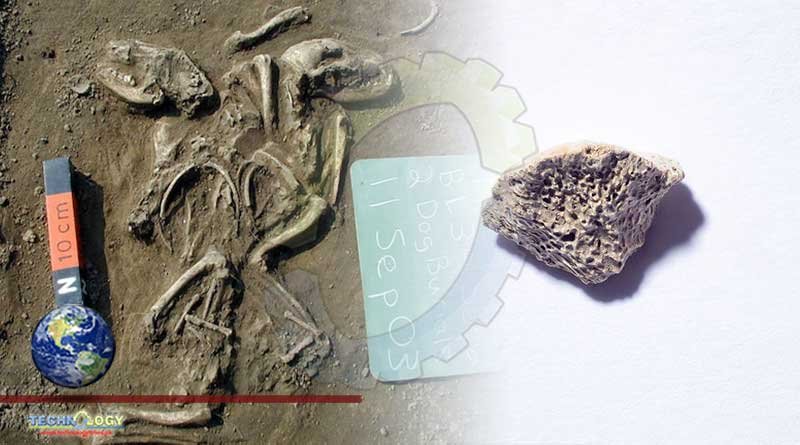Known to experts as PP-00128, the fragment of bone found in a Alaskan cave seemed to be from some large mammal that lived in the area.

For more than a decade, archaeologists thought they were looking at a bear. Known to experts as PP-00128, the fragment of bone found in a southeastern Alaskan cave seemed to be from some large mammal that lived in the area thousands of years ago. But ancient DNA evidence has given this unassuming shard of bone a new identity. The sliver did not belong to a bear, but at 10,150 years old, the most ancient dog yet found in the Americas.
The surprising realization was published today in a study in the Proceedings of the Royal Society B. While looking for Ice Age bear bones to examine, University of Buffalo geneticist Charlotte Lindqvist set about analyzing PP-00128. Perhaps the DNA would reveal what sort of bear the bone came from and how it was related to other ursids. But when Lindqvist and colleagues analyzed the DNA extracted from the bone, they found something very different. This “bear” was a dog.
“Ten or twenty years ago, we would have looked through a pile of bone fragments and not seen this,” says Durham University archaeologist Angela Perri, who was not involved in the new study. “This is a nice example of what can be done with some of these advanced methods,” she adds, noting that mass screening of archaeological material can turn up new clues that might otherwise be missed. Advances in how ancient DNA is extracted, corrected for any modern contaminants and sequenced have allowed researchers to quickly assess the genetics of organisms much faster than ever before, building a growing database that can be used to detect broader patterns. The more ancient DNA that’s recovered, analyzed and placed in the database, the bigger the sample researchers have to work from when trying to understand how organisms—be it dogs or humans— relate to each other.
Dogs have been with humans for a very long time. Around 23,000 years ago, in what’s now Siberia, humans and gray wolves were hemmed in by the encroaching glaciers of the last Ice Age. No one knows for sure exactly how the two species started their relationship, with the leading hypothesis being that the friendlier wolves got used to people who gave them scraps or let them raid garbage piles, but that was the crucible in which the first domesticated dogs were born.
From there, the history of people and dogs was intertwined. Genetic evidence of both humans and dogs, published earlier this year by Perri and colleagues, suggest that they left Eurasia together as people and their pooches crossed the Bering Land Bridge to the ancient Americas together. Now, hot on the heels of that discovery, Lindqvist and colleagues have identified PP-00128 as a genetic cousin of those first Siberian dogs.
In this particular case, the happenstance discovery helps bring some resolution to a disjunction in the archaeological record. “The archaeological evidence for humans and dogs in the New World is sparse and there is a gap in time between archaeological evidence and genetic estimates when it comes to both the entrance of humans and dogs to the Americas south of the ice sheets,” Lindqvist says. The genetics seemed to suggest earlier arrivals for both dogs and people, but the archaeological evidence was often much younger than what the genetics suggested. But by looking at both where PP-00128 existed in time, as well as its genetic connections to both Eurasian and American dogs, a new perspective is starting to come together.
The bone comes from a critical time. Its age is a shade older than other early dog bones found in current-day Illinois, indicating that dogs domesticated in Eurasia spread with people through the Americas. The dogs from the Midwest form a genetic group together with others from places like Alabama and Missouri, part of the dispersal of people through the continent. What makes PP-00128 distinct is that it’s from an earlier group of dogs with ties to Siberia, and its location is especially important. The bone fragment was uncovered in a cave that is close to another archaeological site containing human remains of similar age along the Alaskan coast.
Archaeologists and anthropologists have long debated when and how people traveled from Eurasia across the Bering Land Bridge to the Americas. For decades, the prevailing thought was that migrating groups took advantage of receding ice sheets to take a central corridor between the continents, going through the middle of what’s now Alaska before venturing further south. But the discovery of a domesticated dog along Alaska’s Blake Channel points to a growing body of evidence that people traveled between the continents by moving along the coast, perhaps using early watercraft to move across the wetter stretches. Ice retreated from the coast before the interior, with estimates suggesting that people could have traveled through the area as early as 17,000 years ago and certainly by 15,000 years ago. “I think that their paper most importantly makes a strong case for coastal migration into the Americas,” Perri says, with the peopling of the continent starting with the coasts and later expanding more inland as the ice continued to withdraw.
Additional finds and analysis will test the idea—Perri notes that even earlier dogs are likely to be found along the route between Siberia and Alaska. But the close association between people and dogs so far back in time underscores an important point. “The movement and locations of ancient dogs are proxies to the movement of people, and vice versa, because our histories are closely linked,” Lindqvist says. Not far from where the 10,150-year-old dog bone was found, archaeologists have found 10,300-year-old human remains in a cave called Shuká Káa on nearby Prince of Wales Island, underscoring that people and dogs were here together. As Perri notes, “Where people go, dogs go.”
The emerging picture doesn’t rest on any single discovery, but many different threads. The location, time and genetics of PP-00128 lined up with new hypotheses about when and where both dogs and people arrived in the Americas. Encroaching ice may have brought people and the ancestors of dogs together in Siberia, but when the ice thawed they could begin to travel together. “Sometimes in science it is very exciting when multiple different pieces of evidence come together,” Lindqvist says.
Originally published at Smithsonian Magazine
